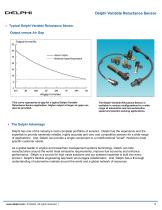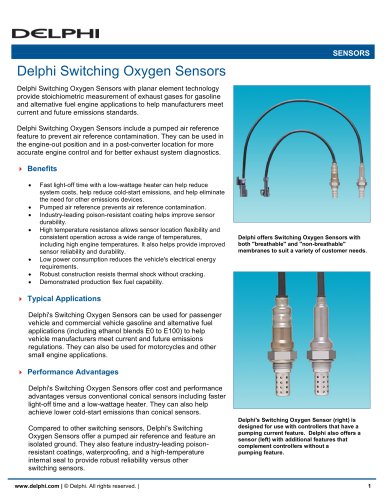
Catalog excerpts

Delphi Variable Reluctance Sensor The Delphi Variable Reluctance Sensor is an electro-magnetic device that measures engine speed and position, transmission speed, and vehicle speed. It is designed for use with control units that accept analog input. Delphi Variable Reluctance Sensor consists of a permanent magnet surrounded by a winding of wire and, for application flexibility, it can be used in conjunction with a ferrous target that has either notches or teeth. Rotation of the target wheel near the tip of the sensor changes the magnetic flux creating an analog voltage signal in the sensor coil that is proportional to the rotating speed and position. The voltage signal is sent to the control unit where it is often converted to a digital signal to support the controlling function. The Delphi Variable Reluctance Sensor is available in both over molded and non-over molded discrete designs, in both sealed and unsealed configurations, and with or without a harness. Delphi Variable Reluctance Sensor Low cost, robust proven speed and position sensing technology Self-generating electrical signal requires no external power supply Fewer wiring connections contribute to excellent reliability Meets a wide range of output, resistance, and inductance requirements so the sensor can be tailored to meet specific customer requirements Typical Applications The Delphi Variable Reluctance Sensor is designed for use in a wide range of automotive applications including engine (cam and crank: speed and position) and transmission (input and output speed). Delphi's Variable Reluctance Sensor is well-suited for a variety of other industrial applications. Performance Advantages The Delphi Variable Reluctance Sensor's non-overmolded coil design and unique termination technique help provide high reliability and low warranty returns. The over molded design offers further cost advantages. Due to their efficient magnetic circuit design and packaging flexibility, Delphi's Variable Reluctance Sensor can be tailored to meet customer objectives for smaller packaging, larger air gap capability, higher temperatures, and maximized output. Performance Specifications Output Air gap Resistance Temperature www.delphi.com | © Delphi. All rights reserved. |
Open the catalog to page 1
Delphi Variable Reluctance Sensor Typical Delphi Variable Reluctance Sensor Output versus Air Gap This curve represents air gap for a typical Delphi Variable Reluctance Sensor application. Higher output at larger air gaps can also be provided. The Delphi Variable Reluctance Sensor is available in various configurations for a wide range of automotive and non-automotive speed and position sensing applications. The Delphi Advantage Delphi has one of the industry's most complete portfolios of sensors. Delphi has the experience and the expertise to provide extremely reliable, highly accurate and...
Open the catalog to page 2All Delphi Power Train catalogs and technical brochures
-
Friction, Discs & Drums
1028 Pages
-
Engine Management, Ignition & Fuel
1460 Pages
-
Turbochargers & DPF
114 Pages
-
Filtration & DPF
709 Pages
-
Air Conditioning & Engine Cooling
771 Pages
-
Delphi Diesel Fuel Injectors
2 Pages
-
Delphi IVT Battery Sensor
1 Pages
-
Delphi Low Pressure Sensors
3 Pages
-
Delphi Ammonia Sensor
2 Pages
-
Delphi Multi-Charge Ignition
2 Pages
-
Delphi OCS Sealed Connectors
4 Pages
-
srs overview
12 Pages
-
Delphi Grounding Systems
2 Pages
-
Delphi Ethernet Connectivity
2 Pages
-
Delphi Smart Injector
2 Pages
-
Heavy Duty & Off-Road Vehicles
100 Pages
-
Passenger Cars & Light Duty Vehicles
100 Pages
-
Delphi Velocity? Tool Suite
2 Pages
-
Ignition Products Catalog
24 Pages
-
Delphi Hybrid Cluster
1 Pages
-
Delphi FAKRA Connectors
2 Pages
-
Product & Service Solutions
8 Pages
-
Powertrain Cooling Systems
8 Pages
-
Hybrid & Electric
8 Pages
Archived catalogs
-
E/E Architecture
8 Pages
-
Delphi corporate brochure
24 Pages
-
Evaporative Emissions
8 Pages
-
Sensors
12 Pages
-
Fuel Handling Systems
6 Pages
-
Valve Train Systems
8 Pages
-
Ignition Systems
8 Pages
-
Exhaust Sensors
8 Pages










































































































